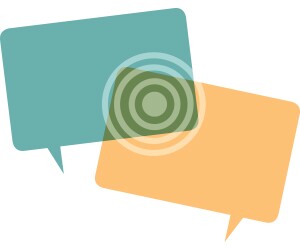Last month, former Presidents Barack Obama and George W. Bush separately issued bipartisan calls to abandon divisive language. Both railed against the current polarized nature of our nation’s political discourse—which, in the past year, has been lacking in nuance and filled with racial invective, gender insults, and other hate speech. Characterized by binaries, this language constructs our nation as a conglomerate of factions.
In such a climate, some educators may shy away from discussing controversial issues with students, especially when, for many of them, the political has become deeply personal. But educators should recognize the power—and opportunities for student empowerment—in these discussions.

Words can be used for disagreements without being divisive. Language is a formidable tool for helping us make sense of the world around us, allowing us to explain to others what we think and feel, and—when we know how to listen—giving us a window into how others understand abstract issues. Language also gives us a medium through which to make sense of the current political turbulence and cultural disquiet. There is power in recognizing and labeling instances of racism, sexism, and discrimination. There is even greater power in giving our students the language to reflect, to question, and to resist negative voices.
As education professors, we have spoken to many teachers who are grappling with how to support diverse learners in a polarized climate. In a survey released last month, researchers at the University of California, Los Angeles, asked more than 1,500 teachers whether the national political discourse during the first months of President Donald Trump’s administration has affected public high school students. Seventy-nine percent of teachers reported that students have expressed concerns for their family’s or their own well-being because of discourse on hot-button issues such as immigration and LGBT rights, and 44 percent said these concerns have affected students’ ability to focus on schoolwork.
Teachers must model respectful dissent by reiterating important ideas and pushing students to explain their thinking."
The Southern Poverty Law Center also documented a post-election increase in bullying incidents of children who are members of linguistic, racial, and religious minority groups. This behavior is linked in part to a lack of precision in our collective discourse—one that reduces individuals to stereotypes.
Making language a mechanism for empowerment rather than division begins by honoring the skills students bring to the classroom and identifying those that are necessary to teach. Over the last six years, in partnership with three U.S. public school districts in Maryland and Massachusetts, we’ve conducted studies examining the language skills of nearly 7,000 students in grades 4-8. Our research suggests that the majority of middle school students—regardless of whether English is the primary language spoken at home—are still developing the skills necessary to discuss complex issues and ideas with nuance, to disagree, and to make their thinking visible to peers.
Even students who are persuasive communicators have not yet learned language helpful for clarifying connections between ideas (such as “as a result” and “however”) or for disagreeing with others (“some think ... but I believe ...”). This kind of language isn’t just window dressing. It helps students to say what they mean more precisely, reducing miscommunication and overgeneralization.
If educators wish to turn discussions about current affairs into a powerful learning opportunity, fostering precise language skills is necessary not only to support the understanding of content, but also to support students to better understand themselves and others. Teaching language builds students’ awareness of language choices and invites them to consider their own linguistic choices.
We have researched effective practices for developing students’ language skills in collaboration with colleagues at Boston University, Harvard University’s Graduate School of Education, the Strategic Education Research Partnership, and Vanderbilt University. In classrooms where we have observed discussion of current events using these guidelines, students demonstrate the capacity to disagree respectfully and to engage with uncertainty at a time when our country is witnessing adults’ inability to do the same.
One of the most important steps is to introduce a few words or phrases at a time and purposefully revisit those new pieces of language. Terms that are transparent to adults often require explicit teaching to children, such as those that cue thinking processes (“summarize” and “conclude”) or signal how ideas connect (“in conclusion” and “on the other hand”). Equally important is how educators motivate students to use the language they learn. Students who want to be understood are more apt to try out new language, but this means that teachers have to give them something worth talking about. It’s helpful to begin with a controversial question.
Educators should then recast themselves as listeners and facilitators. This encourages students to speak up and sharpen their ideas. At the same time, teachers must model respectful dissent by reiterating important ideas and pushing students to explain their thinking. Finally, teachers should help students agree on a few norms for discussion. The goal is not to reach a resolution, but to learn to hold competing narratives in ways that are respectful and move beyond simplistic binaries.
The ongoing national conversation about political and social issues is an important instructional moment for teachers. A central piece of this instruction is helping students to become more skilled at talking, writing, and thinking about issues from multiple perspectives. Teachers would do well to remember the power of language as they help children find their voices in a complex world.



